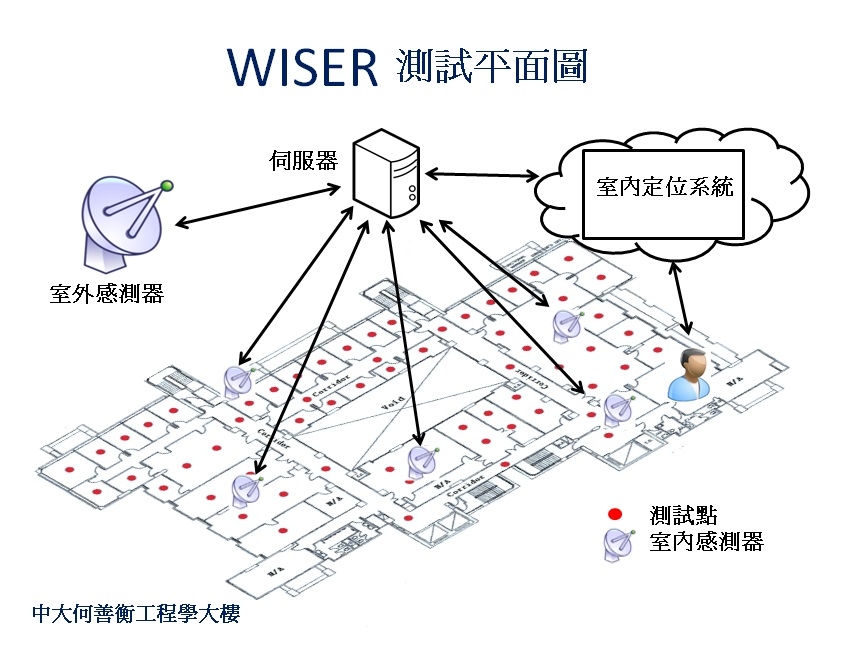CUHK
News Centre
CUHK Faculty of Engineering and Microsoft Research of Hong Kong Jointly Develop WISER to Optimize Indoor Wireless Connectivity Using TV White Spaces
Researchers at The Chinese University of Hong Kong (CUHK) and Microsoft Corp. have successfully developed a new system, WISER (White-space Indoor Spectrum EnhanceR), that improves indoor access to radio frequency spectrum which can enhance the performance of wireless technologies.
In most places, radio spectrum is allocated by strict licensing to different wireless applications in a way that is highly inefficient. Some spectrum frequencies are highly congested while some are idle. A growing number of countries have thus begun to allow users to get access to certain spectrum frequencies on a license-exempt basis, which is similar to Wi-Fi. Given the rapid growth of worldwide demand for radio spectrum in wireless communication, TV white spaces, the unused portions of TV spectrum, offer the first and promising opportunity to provide additional spectrum for users.
“TV white spaces have the potential to provide a significant amount of additional spectrum that is needed for wireless applications,” said Ranveer Chandra, senior researcher at Microsoft. “Although 70 percent of the demand for spectrum comes from indoor environment and significantly more TV band spectrum is left unused indoors than outdoors, most trials and studies of white spaces done before have focused on outdoor scenarios.”
“We identified and formulated the problem with Microsoft in 2010, and have been collaborating on solving the problem in urban locations since then,” said Professor Minghua Chen, Department of Information Engineering, CUHK. “On average we found 40% more TV spectrum to be available indoors, but there was no prior study showing how to use this additional spectrum. Our study addresses that gap.”
WISER – a solution for white space detection
Devices that use white space spectrum for wireless communications must first detect what frequencies are available for use in their current location by dynamic spectrum access (DSA) technologies which can be expensive and difficult to implement. Most regulations allowing DSA requires devices to query a geo-location database to determine available frequencies, but the results are very conservative. There is often more spectrum available for use than indicated by the geo-location database, especially in metropolitan cities such as Hong Kong where the wireless environment is complex.
“The geo-location approach has been studied extensively. While it does work, it has severe limitations,” said Professor Minghua Chen. “As an alternative, we have developed a new system, WISER, that uses sensing technology in a more efficient and cost-effective way than ever before.”
WISER (White-space Indoor Spectrum EnhanceR) is designed to identify and track indoor white spaces in urban locations. Any such system must minimize both the cost of spectrum sensors used and the misidentification of available frequencies. An effective system is able to identify as much vacant spectrum as possible without causing interference by tapping into spectrum that is already in use.
Proven performance
No previous model was able to achieve satisfactory performance at a reasonable cost. WISER optimizes the use of a limited number of sensors, resulting in a more effective and less expensive system. To evaluate the system’s real-world performance, the researchers built and tested a WISER prototype in the Ho Sin Hang Engineering Building on CUHK campus.
“Our results show that WISER can identify 30 to 50 percent more indoor white spaces than other approaches,” said Professor Minghua Chen. “With proper regulation in place, any interested building could adopt WISER to optimize wireless communications using TV white spaces.” “Moreover, these techniques are not limited to TV white spaces and can be broadly used for dynamic spectrum access in other parts of the spectrum as well”, added Chandra.
Regulations allowing unlicensed use of TV white spaces are gaining momentum around the world and are already in place in the U.S. and Finland. Regulators in a number of other countries have undertaken consultations and trials on the use of white spaces, and significant progress has been made by Singapore, the UK and Canada toward commercial deployment. WISER thus has huge potential in wireless communications worldwide.
About CUHK Faculty of Engineering
Founded in 1991, the Faculty of Engineering is committed to the education of future leaders in engineering, the pursuit of knowledge at the frontier of modern technology, and the application of technology to meet societal and human needs.
About Microsoft
Founded in 1975, Microsoft (Nasdaq “MSFT”) is the worldwide leader in software, services and solutions that help people and businesses realize their full potential.









